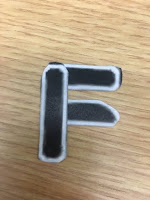 Today's lecture was about emotional engagement and meaningful communication, presented by Tracy Lannon. We looked at how engaging in different types of information would help us create designs with meaning and have some purpose to others. Throughout the presentation we looked at image illusions and how others view them differently. Illusions are created using certain angles, patterns and colours to present an image that the eye cannot understand, we as humans have to filter things down to make sense of happenings. Our expectations dictate our emotional attachment: we look for the same kind of things, preparing us for what we will see next time and what we want to take notice of e.g. The image either shows a white vase or two faces looking directly at each other, it is known that most people look at the faces first because they are something we see in everyday life and there is more focus than a vase.
Today's lecture was about emotional engagement and meaningful communication, presented by Tracy Lannon. We looked at how engaging in different types of information would help us create designs with meaning and have some purpose to others. Throughout the presentation we looked at image illusions and how others view them differently. Illusions are created using certain angles, patterns and colours to present an image that the eye cannot understand, we as humans have to filter things down to make sense of happenings. Our expectations dictate our emotional attachment: we look for the same kind of things, preparing us for what we will see next time and what we want to take notice of e.g. The image either shows a white vase or two faces looking directly at each other, it is known that most people look at the faces first because they are something we see in everyday life and there is more focus than a vase. Visual Sti
 mulation:
mulation:All the information we receive is upside down, our brain flips the image and sends it to another part that best fits to understand what it is we are looking at. The retina in our eye is made up of two cells: the cone cells which only see black and white and the rod cells that see colours. We looked at two tests, the first: draw a cross and a dot on separate sides of a piece of paper, cover one eye and move the paper in our vision from side to side - when the dot or cross were out of our vision the cells were not able to work.

The second test was to look at the circles on the left hand side and pick out the numbers in each shape. With all the different dots and colours involved in the images it shows that colour blind people would not be able to understand what the number is inside the shape.












